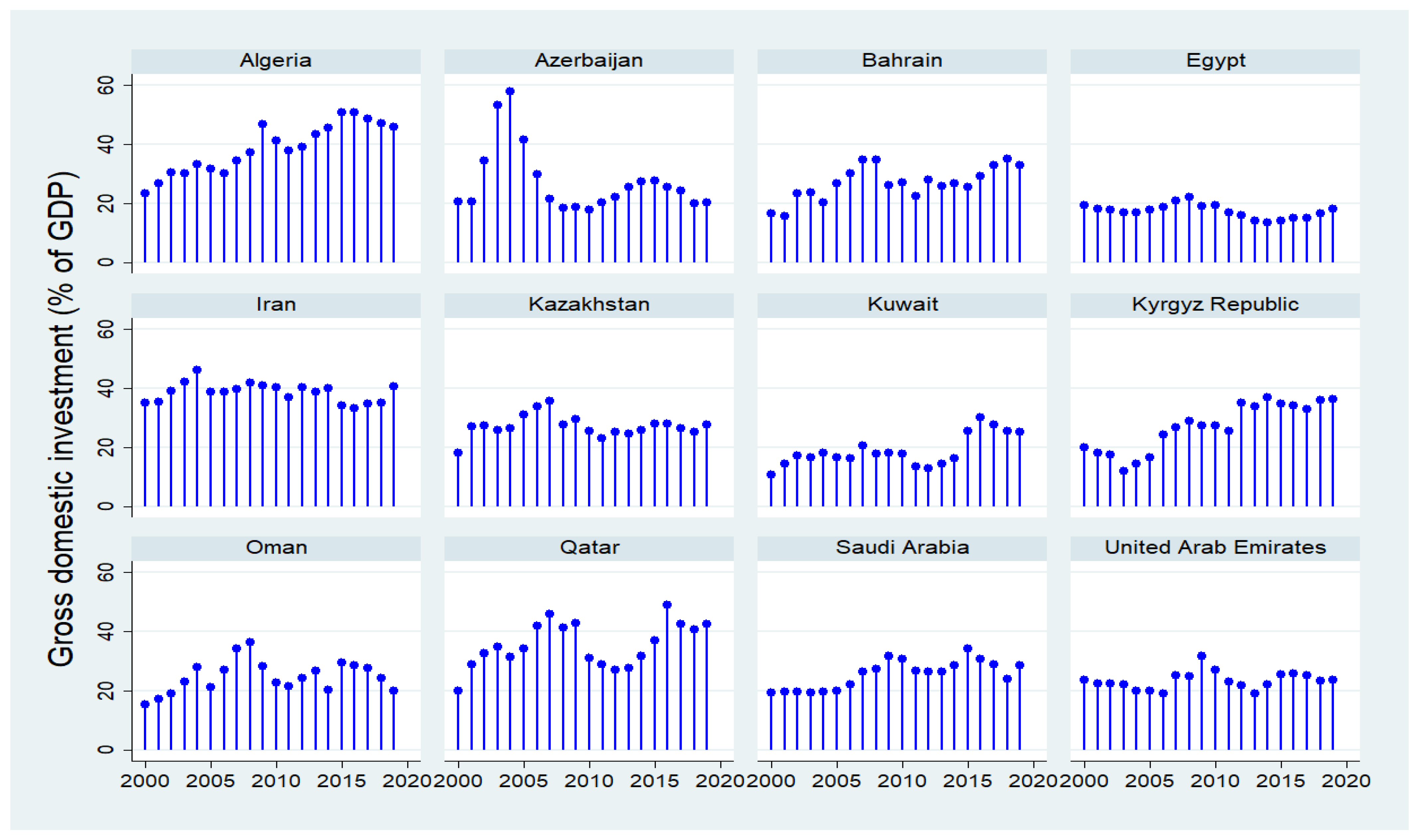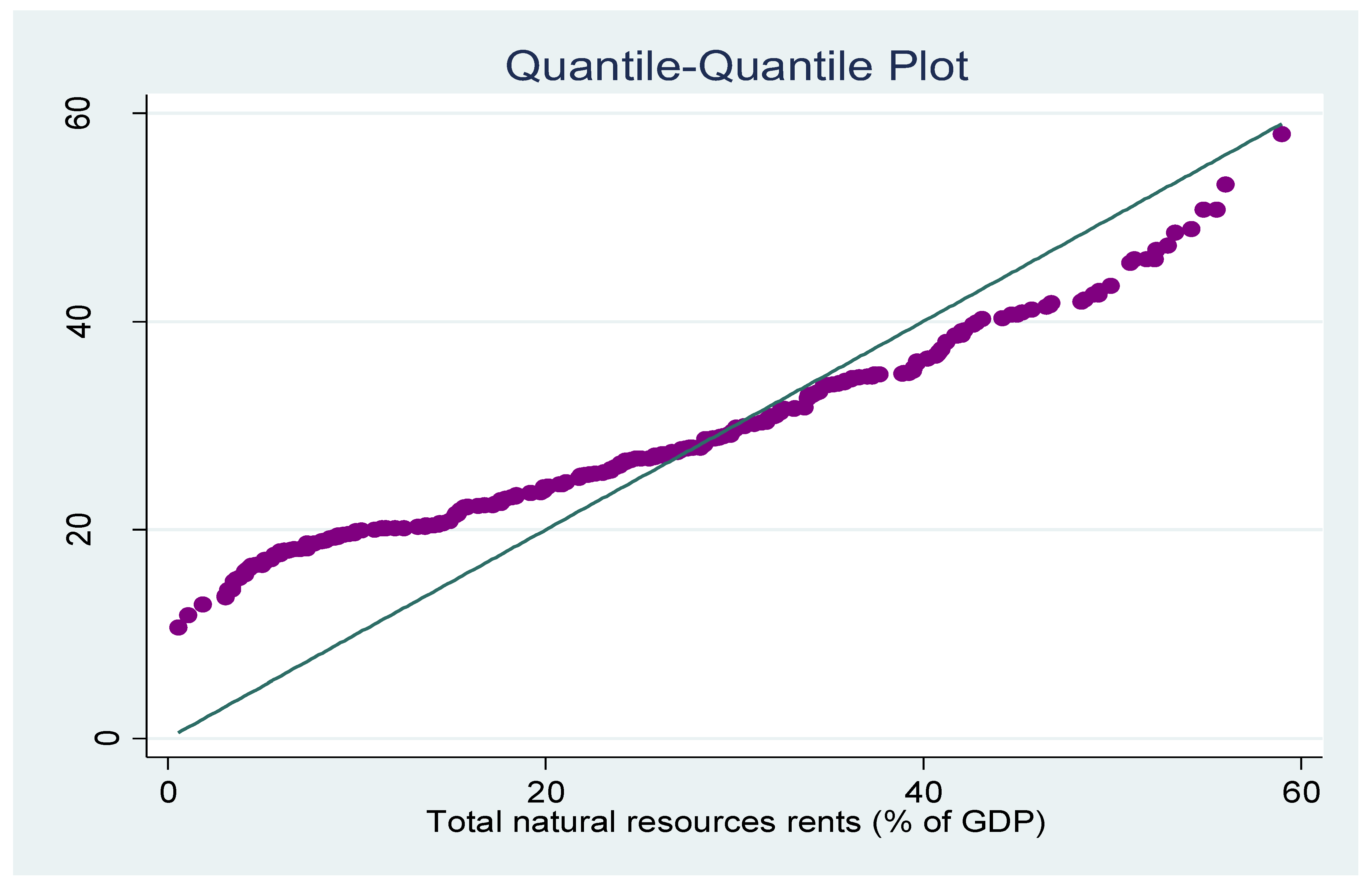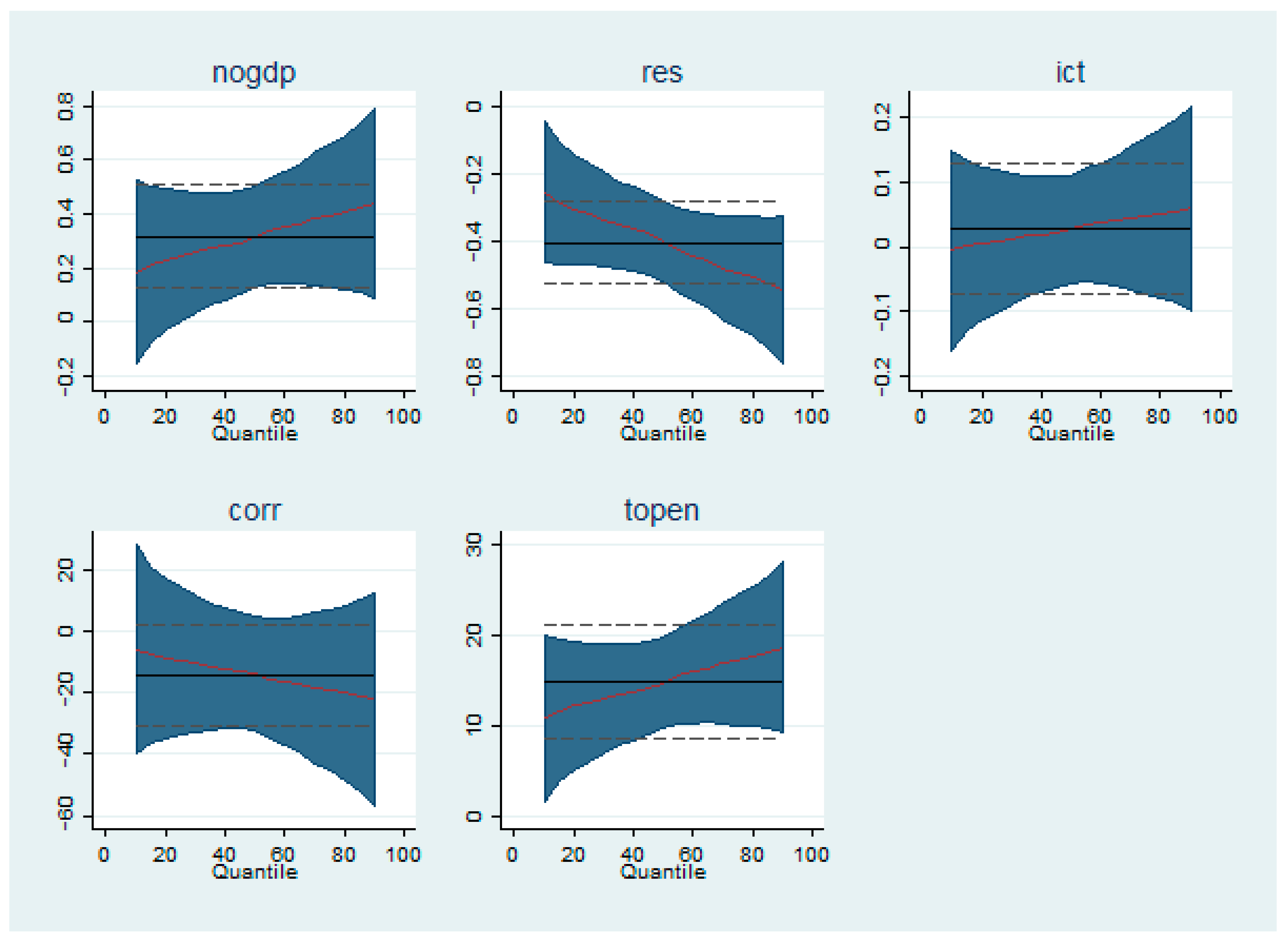Crowding-Out Effect of Natural Resources on Domestic Investment: The Importance of Information Communication and Technology (ICT) and Control of Corruption in the Middle East and Central Asia
Abstract
1. Introduction
2. Survey of Literature
2.1. Natural Resources and Domestic Investment
2.2. ICT and Domestic Investment
2.3. Corruption and Domestic Investment
2.4. The Gap in the Literature
3. Methodology
3.1. Model Specification
3.2. Estimation Strategy
3.2.1. Cross-Sectional Dependence
3.2.2. Unit Root Analysis and Slop Homogeneity
3.2.3. CS-ARDL Model
3.2.4. Panel Quantile Regression
4. Results and Discussion
4.1. Pre-Diagnostic Test
4.2. Analysis of Major Findings
5. Conclusions
Author Contributions
Funding
Institutional Review Board Statement
Informed Consent Statement
Data Availability Statement
Acknowledgments
Conflicts of Interest
References
- Aysan, A.F.; Nabli, M.K.; Véganzonès-Varoudakis, M.A. Governance Institutions and Private Investment: An Application to the Middle East and North Africa. Dev. Econ. 2007, 45, 339–377. [Google Scholar] [CrossRef]
- Domar, E. Capital Expansion, Rate of Growth, and Employment. Econom. J. Econom. Soc. 1946, 14, 137–147. [Google Scholar] [CrossRef]
- Harrod, R. An Essay in Dynamic Theory. Econ. J. 1939, 49, 14–33. [Google Scholar] [CrossRef]
- Solow, R.M. A Contribution to the Theory of Economic Growth. Q. J. Econ. 1956, 70, 65–94. [Google Scholar] [CrossRef]
- Swan, T.W. Economic Growth and Capital Accumulation. Econ. Rec. 1956, 32, 334–361. [Google Scholar] [CrossRef]
- Mankiw, G.N.; Romer, D.; Weil, D.N. A Contribution to the Empirics of Economic Growth. Q. J. Econ. 1992, 107, 407–437. [Google Scholar] [CrossRef]
- Romer, P.M. Increasing Returns and Long-Run Growth. J. Polit. Econ. 1986, 94, 1002–1037. [Google Scholar] [CrossRef]
- World Bank World Development Indicators. Available online: https://databank.worldbank.org/indicator/NY.GDP.MKTP.KD.ZG/1ff4a498/Popular-Indicators (accessed on 20 August 2020).
- Hordofa, T.T.; Liying, S.; Mughal, N.; Arif, A.; Minh Vu, H.; Kaur, P. Natural Resources Rents and Economic Performance: Post-COVID-19 Era for G7 Countries. Resour. Policy 2022, 75, 102441. [Google Scholar] [CrossRef]
- Sala-i-Martin, X.; Subramanian, A. Addressing the Natural Resource Curse: An Illustration from Nigeria. J. Afr. Econ. 2013, 22, 570–615. [Google Scholar] [CrossRef]
- Gylfason, T.; Zoega, G. Natural Resources and Economic Growth: The Role of Investment. World Econ. 2006, 29, 1091–1115. [Google Scholar] [CrossRef]
- Amiri, H.; Samadian, F.; Yahoo, M.; Jamali, S.J. Natural Resource Abundance, Institutional Quality and Manufacturing Development: Evidence from Resource-Rich Countries. Resour. Policy 2019, 62, 550–560. [Google Scholar] [CrossRef]
- Asif, M.; Khan, K.B.; Anser, M.K.; Nassani, A.A.; Abro, M.M.Q.; Zaman, K. Dynamic Interaction between Financial Development and Natural Resources: Evaluating the ‘Resource Curse’ Hypothesis. Resour. Policy 2020, 65, 101566. [Google Scholar] [CrossRef]
- Guan, J.; Kirikkaleli, D.; Bibi, A.; Zhang, W. Natural Resources Rents Nexus with Financial Development in the Presence of Globalization: Is the “Resource Curse” Exist or Myth? Resour. Policy 2020, 66, 101641. [Google Scholar] [CrossRef]
- Sinha, A.; Sengupta, T. Impact of Natural Resource Rents on Human Development: What Is the Role of Globalization in Asia Pacific Countries? Resour. Policy 2019, 63, 101413. [Google Scholar] [CrossRef]
- Yilanci, V.; Aslan, M.; Ozgur, O. Disaggregated Analysis of the Curse of Natural Resources in Most Natural Resource-Abundant Countries. Resour. Policy 2021, 71, 102017. [Google Scholar] [CrossRef]
- Park, I.; Lee, J.; Nam, J.; Jo, Y.; Lee, D. Which Networking Strategy Improves ICT Startup Companies’ Technical Efficiency? Manag. Decis. Econ. 2022, 43, 2434–2443. [Google Scholar] [CrossRef]
- Samargandi, N.; Al Mamun, M.; Sohag, K.; Alandejani, M. Women at Work in Saudi Arabia: Impact of ICT Diffusion and Financial Development. Technol. Soc. 2019, 59, 101187. [Google Scholar] [CrossRef]
- Zhang, C.; Khan, I.; Dagar, V.; Saeed, A.; Zafar, M.W. Environmental Impact of Information and Communication Technology: Unveiling the Role of Education in Developing Countries. Technol. Forecast. Soc. Chang. 2022, 178, 121570. [Google Scholar] [CrossRef]
- Commander, S.; Harrison, R.; Menezes-Filho, N. ICT Adoption and Productivity in Developing Countries: New Firm Level Evidence from Brazil and India. Rev. Econ. Stat. 2011, 93, 528–541. [Google Scholar] [CrossRef]
- Hong, J.P. Causal Relationship between ICT R&D Investment and Economic Growth in Korea. Technol. Forecast. Soc. Chang. 2017, 116, 70–75. [Google Scholar] [CrossRef]
- Nchofoung, T.N.; Asongu, S.A. ICT for Sustainable Development: Global Comparative Evidence of Globalisation Thresholds. Telecomm. Policy 2022, 46, 102296. [Google Scholar] [CrossRef]
- Saha, S.; Ali, M.S.B. Corruption and Economic Development: New Evidence from the Middle Eastern and North African Countries. Econ. Anal. Policy 2017, 54, 83–95. [Google Scholar] [CrossRef]
- Belloumi, M.; Alshehry, A.S. The Causal Relationships Between Corruption, Investments and Economic Growth in GCC Countries. SAGE Open 2021, 11, 21582440211054425. [Google Scholar] [CrossRef]
- Ang, J.B. Do Public Investment and FDI Crowd in or Crowd out Private Domestic Investment in Malaysia? Appl. Econ. 2009, 41, 913–919. [Google Scholar] [CrossRef]
- Wang, M. Foreign Direct Investment and Domestic Investment in the Host Country: Evidence from Panel Study. Appl. Econ. 2009, 41, 3711–3721. [Google Scholar] [CrossRef]
- Herzer, D.; Grimm, M. Does Foreign Aid Increase Private Investment? Evidence from Panel Cointegration. Appl. Econ. 2012, 44, 2537–2550. [Google Scholar] [CrossRef]
- Abbas, S. Workers’ Remittances and Domestic Investment in South Asia: A Comparative Econometric Inquiry. Int. Migr. 2019, 57, 89–104. [Google Scholar] [CrossRef]
- Abbas, S.; Sohag, K.; Suleman, S. Income from International Tourism and Domestic Investment in South Asia: Evidence from Heterogeneous Panel Econometrics Income from International Tourism and Domestic Investment In. Curr. Issues Tour. 2022, 1–16. [Google Scholar] [CrossRef]
- Baldwin, R.E. Patterns of Development in Newly Settled Regions. Manch. Sch. 1956, 24, 161–179. [Google Scholar] [CrossRef]
- Rajan, R.G.; Subramanian, A. Aid, Dutch Disease, and Manufacturing Growth. J. Dev. Econ. 2011, 94, 106–118. [Google Scholar] [CrossRef]
- Sachs, J.D.; Warner, A.M. The Big Push, Natural Resource Booms and Growth. J. Dev. Econ. 1999, 59, 43–76. [Google Scholar] [CrossRef]
- Sachs, J.; Warner, A. Natural Resource Abundance and Economic Growth; National Bureau of Economic Research: Cambridge, MA, USA, 1995; Volume 3. [Google Scholar] [CrossRef]
- Sadik-Zada, E.R. Distributional Bargaining and the Speed of Structural Change in the Petroleum Exporting Labor Surplus Economies; Palgrave Macmillan: London, UK, 2020; Volume 32, ISBN 0123456789. [Google Scholar]
- Sadik-Zada, E.R.; Gatto, A.; Niftiyev, I. E-government and petty corruption in public sector service delivery. Technol. Anal. Strateg. Manag. 2022, 1–17. [Google Scholar] [CrossRef]
- Niftiyev, I. Dutch Disease Effects in the Azerbaijan Economy: Results of Multivariate Linear Ordinary Least Squares (Ols) Estimations. HSE Econ. J. 2021, 25, 309–346. [Google Scholar] [CrossRef]
- Niftiyev, I. Dutch Disease Symptoms in Azerbaijan Economy. J. Econ. Coop. Dev. 2020, 41, 33–67. [Google Scholar]
- Latif, Z.; Latif, S.; Ximei, L.; Pathan, Z.H.; Salam, S.; Jianqiu, Z. The Dynamics of ICT, Foreign Direct Investment, Globalization and Economic Growth: Panel Estimation Robust to Heterogeneity and Cross-Sectional Dependence. Telemat. Inform. 2018, 35, 318–328. [Google Scholar] [CrossRef]
- Zafar, M.W.; Zaidi, S.A.H.; Mansoor, S.; Sinha, A. Technological Forecasting & Social Change ICT and Education as Determinants of Environmental Quality: The Role of Financial Development in Selected Asian Countries. Technol. Forecast. Soc. Chang. 2022, 177, 121547. [Google Scholar] [CrossRef]
- Tang, C.; Xue, Y.; Wu, H.; Irfan, M.; Hao, Y. How Does Telecommunications Infrastructure Affect Eco-Efficiency? Evidence from a Quasi-Natural Experiment in China. Technol. Soc. 2022, 69, 101963. [Google Scholar] [CrossRef]
- Tirole, J. A Theory of Collective Reputations (with Applications to the Persistence of Corruption and to Firm Quality). Rev. Econ. Stud. 1996, 63, 1–22. [Google Scholar] [CrossRef]
- Bardhan, P. Corruption and Development: A Review of Issues. J. Econ. Lit. 1997, 35, 1320–1346. [Google Scholar] [CrossRef]
- Mauro, P. Corruption and Growth. Q. J. Econ. 1995, 110, 681–712. [Google Scholar] [CrossRef]
- Shleifer, A.; Vishny, R.W. Corruption. Q. J. Econ. 1993, 108, 599–617. [Google Scholar] [CrossRef]
- Leff, N.H. Economic Development through Bureaucratic Corruption. Am. Behav. Sci. 1964, 8, 8–14. [Google Scholar] [CrossRef]
- Heo, Y.; Hou, F.; Park, S.G. Does Corruption Grease or Sand the Wheels of Investment or Innovation? Different Effects in Advanced and Emerging Economies. Appl. Econ. 2021, 53, 35–60. [Google Scholar] [CrossRef]
- Yiheyis, Z.; Woldemariam, K. The Effect of Remittances on Domestic Capital Formation in Selected African Countries: A Comparative Empirical Analysis. J. Int. Dev. 2016, 28, 243–265. [Google Scholar] [CrossRef]
- IMF Regional Economic Outlook: Middle East and Central Asia. Available online: https://data.imf.org/?sk=4cc54c86-f659-4b16-abf5-fab77d52d2e6&sId=1390030341854 (accessed on 15 July 2022).
- QoG The Quality of Government Basic Dataset 2021-Time Series. Available online: https://www.gu.se/en/quality-government/qog-data/data-downloads (accessed on 15 July 2022).
- Gründler, K.; Potrafke, N. Corruption and Economic Growth: New Empirical Evidence. Eur. J. Polit. Econ. 2019, 60, 101810. [Google Scholar] [CrossRef]
- Baldock, G. The Perception of Corruption across Europe, Middle East and Africa. J. Financ. Crime 2019, 26, 372–381. [Google Scholar] [CrossRef]
- Warf, B. Corruption in the Middle East and North Africa: A Geographic Perspective. Arab World Geogr. 2014, 18, 1–18. [Google Scholar]
- Ndikumana, L. Financial Determinants of Domestic Investment in Sub-Saharan Africa: Evidence from the Panel Data. World Dev. 2000, 28, 381–400. [Google Scholar] [CrossRef]
- Breusch, T.S.; Pagan, A.R. The Lagrange Multiplier Test and Its Applications to Model Specification in Econometrics. Rev. Econ. Stud. 1980, 47, 239. [Google Scholar] [CrossRef]
- Baltagi, B.H.; Feng, Q.; Kao, C. A Lagrange Multiplier Test for Cross-Sectional Dependence in a Fixed Effects Panel Data Model. J. Econom. 2012, 170, 164–177. [Google Scholar] [CrossRef]
- Pesaran, M.H. General Diagnostic Tests for Cross-Sectional Dependence in Panels. Empir. Econ. 2021, 60, 13–50. [Google Scholar] [CrossRef]
- Pesaran, M.H. A Simple Panel Unit Root Test in the Presence of Cross-Section Dependence. J. Appl. Econom. 2007, 22, 265–312. [Google Scholar] [CrossRef]
- Pesaran, M.H.; Yamagata, T. Testing Slope Homogeneity in Large Panels. J. Econom. 2008, 142, 50–93. [Google Scholar] [CrossRef]
- Chudik, A.; Pesaran, M.H. Common Correlated Effects Estimation of Heterogeneous Dynamic Panel Data Models with Weakly Exogenous Regressors. J. Econom. 2015, 188, 393–420. [Google Scholar] [CrossRef]
- Koenker, R.; Bassett, G. Regression Quantiles. Econometrica 1978, 46, 33–50. [Google Scholar] [CrossRef]
- Ghura, D.; Goodwin, B. Determinants of Private Investment: A Cross-Regional Empirical Investigation. Appl. Econ. 2000, 32, 1819–1829. [Google Scholar] [CrossRef]




| Variables | Definition | Source | Mean | Max | Standard Deviation |
|---|---|---|---|---|---|
| INV | Gross fixed capital formation, % of GDP. | World Bank, [8] | 27.623 | 57.99 | 8.996 |
| NOGDPG | Non-oil GDP * growth, constant prices, percentage change | IMF, [48] | 5.897 | 38.72 | 4.867 |
| RES | Natural resources rent, % of GDP | World Bank, [8] | 24.813 | 58.983 | 14.375 |
| ICT | Information communication and technology (Fixed broadband subscriptions per 100 people | QoG, [49] | 17.149 | 90.2 | 12.201 |
| CORR | Political corruption index | QoG, [49] | 0.428 | 0.628 | 0.263 |
| TOPEN | Trade openness index | World Bank, [8] | 0.899 | 1.918 | 0.336 |
| INV | NOGDPG | RES | ICT | CORR | TOPEN | |
|---|---|---|---|---|---|---|
| INV | 1 | |||||
| NOGDP | 0.3687 | 1 | ||||
| 0.000 | ||||||
| RES | −0.1903 | 0.0308 | 1 | |||
| 0.0197 | 0.063 | |||||
| ICT | 0.55 | 0.1183 | 0.3751 | 1 | ||
| 0.041 | 0.0821 | 0.089 | ||||
| CORR | −0.4404 | −0.2354 | −0.183 | 0.4516 | 1 | |
| 0.05 | 0.045 | 0.071 | 0.125 | |||
| TOPEN | 0.369 | 0.1775 | −0.1767 | 0.2262 | 0.056 | 1 |
| 0.00 | 0.000 | 0.124 | 0.000 | 0.312 |
| Cross-Sectional Dependency | Unit Root Test | |||
|---|---|---|---|---|
| Variables | CD Test | Correlation | CIPS I(0) | CIPS I(1) |
| INV | 7.42 *** | 0.204 | −1.867 | −4.205 *** |
| NOGDPG | 11.75 *** | 0.323 | −3.267 *** | −5.256 *** |
| RES | 24.29 *** | 0.668 | −2.326 ** | −3.511 *** |
| ICT | 11.21 *** | 0.309 | −2.976 *** | −4.922 *** |
| CORR | 4.82 *** | 0.133 | −1.401 | −3.782 *** |
| TOPEN | 5.32 *** | −0.146 | 1.941 | −4.410 *** |
| Test Statistics | Probability | |
|---|---|---|
| Delta | −2.315 | 0.010 |
| Delta adjusted | −4.102 | 0.000 |
| Model 1 (CD in SR) | Model 2 (CD in LR) | Model 3 (CD in SR & LR) | |
|---|---|---|---|
| Long run | |||
| NOGDPG | 1.745 * | 1.194 *** | 1.122 *** |
| (1.85) | (8.48) | (27.07) | |
| RES | −1.337 *** | −0.712 *** | −0.791 *** |
| (3.03) | (−9.91) | (−5.54) | |
| ICT | 1.059 * | 0.215 *** | 0.338 *** |
| (1.79) | (4.47) | (3.25) | |
| CORR | −1.582 * | −1.190 | −3.296 ** |
| (−1.86) | (−0.71) | (−2.30) | |
| TOPEN | 1.382 | 3.961 | 2.215 |
| (1.46) * | (7.71) | (7.48) | |
| Short run | |||
| ∆NOGDPG | 0.146 | 2.57 *** | 2.242 ** |
| (1.18) | (2.80) | (2.45) | |
| ∆RES | −0.434 | −0.516 *** | −0.536 *** |
| −1.21 | (−4.88) | (−4.44) | |
| ∆ICT | 0.790 | 0.605 | 0.655 |
| (0.99) | (1.08) | (1.07) | |
| ∆CORR | 2.843 | −13.070 | 3.227 |
| (0.65) | (−0.38) | (1.52) | |
| ∆TOPEN | 1.685 | 1.609 *** | 1.916 |
| (1.48) | (2.82) | (0.07) | |
| Error correction | −0.033 * | −0.274 *** | −0.285 ** |
| (−1.74) | (−3.37) | (−2.47) | |
| constant | −6.172 | 2.894 ** | 1.468 ** |
| (−0.74) | (2.05) | (3.13) | |
| Quantile 20 | Quantile 40 | Quantile 60 | Quantile 80 | |
|---|---|---|---|---|
| NOGDPG | 0.231 * | 0.281 *** | 0.352 *** | 0.407 *** |
| (1.73) | (5.68) | (3.32) | (2.80) | |
| RES | −0.3.5 *** | −0.62 *** | −0.443 *** | −0.506 *** |
| (−3.66) | (−5.65) | (−6.60) | (5.58) | |
| ICT | 0.591 | 0.185 * | 0.364 * | 0.506 ** |
| (1.09) | (1.69) | (1.76) | (2.22) | |
| CORR | −1.729 | −2.958 * | −1.424 * | −2.57 * |
| (−0.66) | (−1.79) | (−1.71) | (−1.81) | |
| TOPEN | 2.185 *** | 3.753 *** | 3.919 *** | 4.624 *** |
| (3.36) | (4.98) | (5.51) | (4.46) |
Publisher’s Note: MDPI stays neutral with regard to jurisdictional claims in published maps and institutional affiliations. |
© 2022 by the authors. Licensee MDPI, Basel, Switzerland. This article is an open access article distributed under the terms and conditions of the Creative Commons Attribution (CC BY) license (https://creativecommons.org/licenses/by/4.0/).
Share and Cite
Abbas, S.; Rehman, F.U.; Khan, S.; Rehman, M.Z.; Alonazi, W.B.; Noman, A.A. Crowding-Out Effect of Natural Resources on Domestic Investment: The Importance of Information Communication and Technology (ICT) and Control of Corruption in the Middle East and Central Asia. Sustainability 2022, 14, 13392. https://doi.org/10.3390/su142013392
Abbas S, Rehman FU, Khan S, Rehman MZ, Alonazi WB, Noman AA. Crowding-Out Effect of Natural Resources on Domestic Investment: The Importance of Information Communication and Technology (ICT) and Control of Corruption in the Middle East and Central Asia. Sustainability. 2022; 14(20):13392. https://doi.org/10.3390/su142013392
Chicago/Turabian StyleAbbas, Shujaat, Faheem Ur Rehman, Shabeer Khan, Mohd Ziaur Rehman, Wadi B. Alonazi, and Abul Ala Noman. 2022. "Crowding-Out Effect of Natural Resources on Domestic Investment: The Importance of Information Communication and Technology (ICT) and Control of Corruption in the Middle East and Central Asia" Sustainability 14, no. 20: 13392. https://doi.org/10.3390/su142013392
APA StyleAbbas, S., Rehman, F. U., Khan, S., Rehman, M. Z., Alonazi, W. B., & Noman, A. A. (2022). Crowding-Out Effect of Natural Resources on Domestic Investment: The Importance of Information Communication and Technology (ICT) and Control of Corruption in the Middle East and Central Asia. Sustainability, 14(20), 13392. https://doi.org/10.3390/su142013392






